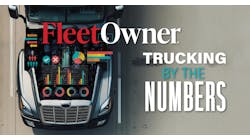I have often mentioned my involvement in fantasy football over the years in this column—and after this season’s disappointing results, I’ll employ a different draft philosophy next time. One strategy that won’t change: I’ll continue to draft high performers. As we start another year, this philosophy also is being implemented at the U.S. Department of Transportation with DOT’s National Roadway Safety Strategy (NRSS).
With fatality rates on our nation’s roadways trending downward, DOT and its operating administrations have invested their time, effort, and future regulatory authority to reduce roadway deaths even more. Using the same strategy of backing high performers, officials at the Federal Motor Carrier Safety Administration will certainly begin to emphasize the tools that have proven to be excellent performers when it comes to accident-reduction technology.
See also: What fleets should know about clearinghouse changes for 2023
By mentioning high performers, I am referring to the technologies that the members of the Truckload Carriers Association have put in place, because they actually work as intended, and the tech improves upon TCA member fleets’ safety performance by reducing the severity of accidents, the opportunity to be involved in accidents, and even helps avoid crashes altogether. Tech such as automatic emergency braking and lane departure warnings have woven their way into the regulatory landscape and are endorsed by the Biden administration’s National Roadway Safety Strategy.
High performers. Check. A strategy that has capitalized on technology that has proven itself to the trucking industry. Check. Even speed control reverberates throughout the NRSS, as a speed-limiter rule, proposed in 2022, sparking much debate, garnered more than 15,000 comments, though regulators must still sift through them all. Speed-governing technologies have changed and the benefits are there, including increased flexibility for the tractors that utilize them, making speed control a far cry from what they used to be.
See also: New, pending, and possible rules and regulations facing fleets in 2023
When reading through the National Roadway Safety Strategy, one can’t help but recognize that it could serve as a regulatory blueprint for what was once known as the Beyond Compliance initiative, which sought to identify positive behavior and technology within trucking that could be leveraged for greater good. Focusing on the positive steps the industry would take toward improving safety within their fleets could be beneficial to all who use them. However, with the regulatory process that is certain to follow, NRSS takes the positive outcomes that fleets across the country have experienced and turns them into regulation for the entire industry now.
Lest hair testing be left behind
NRSS is a more-than-solid framework that could drive accident trends back in the right direction, but I also must call into question a safety improvement it seemingly would leave behind. I write now of one of the clear instances where hypocrisy on the part of regulators seems to shun what would be an important safety practice.
The Biden administration sees hair-follicle testing as a safety measure, but I wonder why it’s not yet sanctioned by the regulators in charge of trucking. Hair testing—which has a wider detection window for illicit drug use—has clear benefits over just urine screening, thus having hair-testing results accepted by the Drug & Alcohol Clearinghouse should be seen as an alternative measure that would improve safety by identifying more drug users (some say many more) behind the wheel of commercial vehicles today.
See also: Opinion: Why not hair testing?
Drug-testing protocols aren’t governed by DOT, nor are they regulated by the Federal Motor Carrier Safety Administration (both waived the white flag on hair testing again just before Christmas). But the U.S. Department of Health and Human Services does have oversight. All these agencies fall under President Biden’s authority, so reducing highway fatalities should be their main objective. Jurisdiction shouldn’t be an excuse for more delay. Even the National Transportation Safety Board, which isn’t even a regulating authority, leans into preventing alcohol- and drug-impaired driving on its “Most Wanted” list, so the case for hair testing is rather irrefutable.
And the data speaks for itself. In 2021, more than 88,000 CDL-holders applied for jobs at seven trucking companies, and those applicants were asked to have both their hair and urine tested. Just over 400 drivers tested positive in the urine tests; 4,000 popped positive results from screening their hair.
Every possible way to improve safety, especially if it has been proven successful by our industry, should be deployed, regardless of which administrative authority is responsible. For a roadway safety strategy to be truly national, every party needs to take responsibility for our nationwide numbers to improve.
David Heller is the senior vice president of safety and government affairs at the Truckload Carriers Association. Heller has worked for TCA since 2005, initially as director of safety, and most recently as the VP of government affairs.




